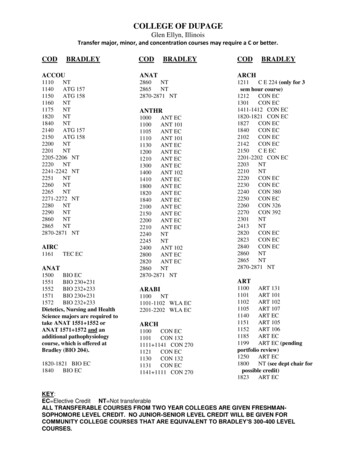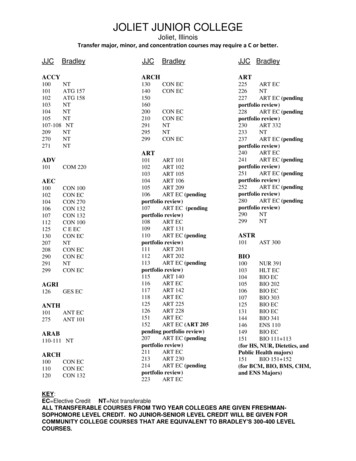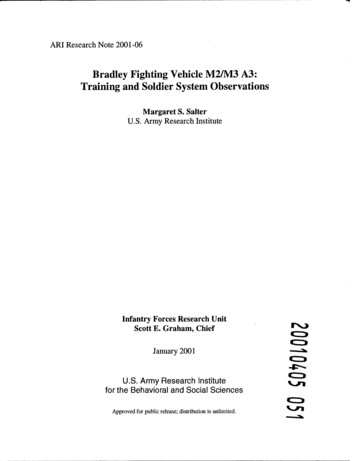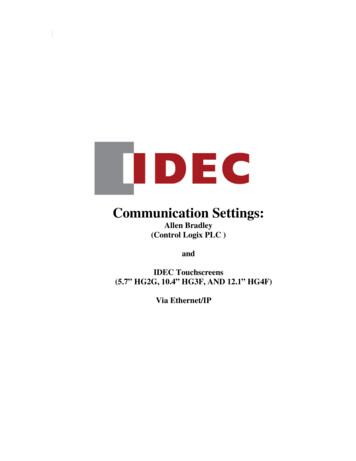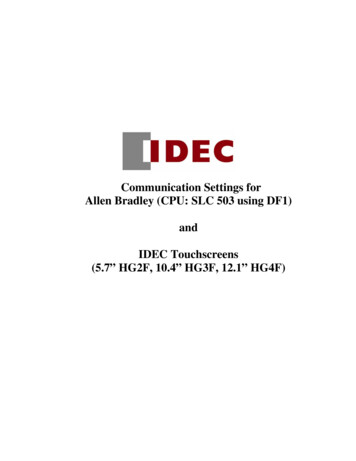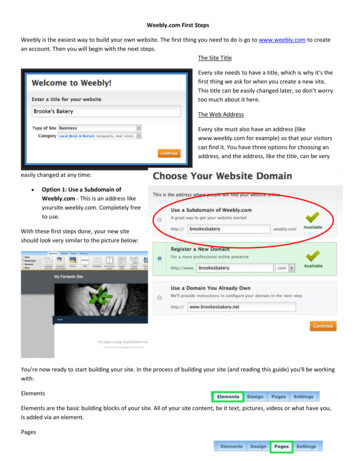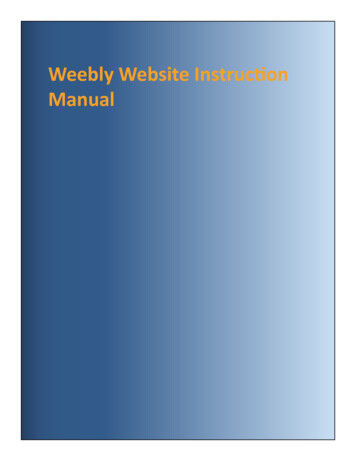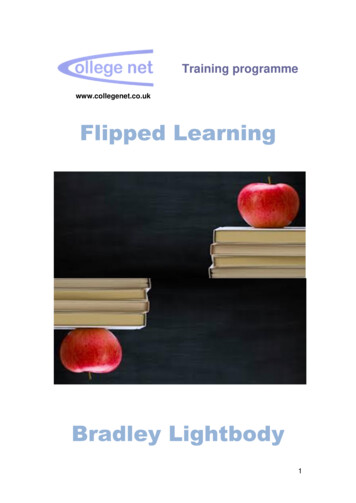
Transcription
Training programmewww.collegenet.co.ukFlipped LearningBradley Lightbody1
AIMTo introduce and apply the concept of Flipped LearningKey QuestionsDelegates will be able to: What is flipped learning?How will flipped learning alter my lessons?How will I engage my students in flipped learning?This programme is designed to provide teaching staff with an overview of howto introduce and support ‘flipped learning’. This is one of several programmesoffered by Collegenet. To view the full range of training options please visitthe training page of Collegenet.co.uk or email bradley@collegenet.co.ukPresenterThis session will be presented by Bradley Lightbody, Managing Director,Collegenet Limited and author of ‘Taking Your A-Levels (1996), ‘The ColdWar (1999), ‘the Second World War’ (2004), ‘Outstanding Teaching andLearning 14-19’ (2009) and ‘The i-Learning Revolution: A new pedagogy(2012). The Second Edition of ‘Outstanding teaching and learning 14-19’ waspublished October 2012. The Second Edition is fully updated with the newOfsted 2012 inspection criteria and the latest academic evidence arising fromThe Sutton Trust, OECD, Pisa, Mckinsey reports and Professor John Hattie.Books may be ordered via Amazon or with a 2 discount from the onlinebookstore on Collegenet.co.ukOutstanding teachingAnd learning 14-19Bradley Lightbody2
In praise of ‘flipped Learning’The following article appeared in The Economist magazine in 2011 highlightinga research paper published in the Science Journal 13th May 2011. The articlereports on the outcome of a controlled experiment conducted by Dr LouisDeslauriers with 850 Physics students attending the University of BritishColumbia. The students were divided into a ‘flipped learning’ group and atraditional ‘chalk and talk’ group to study one major course topic in parallel .“The students were split into groups at the start of their course and for the first11 weeks all went to traditionally run lectures given by well-regarded andexperienced teachers. In the 12th week one of the groups was switched to astyle of teaching known as ‘deliberate practice’ ( i.e flipped learning) whichinverts the traditional university model. Class time is spent on problemsolving, discussion and group work while the absorption of facts and formulaeis left for homework. Students were given reading assignments beforeclasses. Once in the classroom they spent their time in small groups,discussing specific problems with the teacher roaming between groups tooffer advice and respond to questions. At the end of the test week DrDeslauriers surveyed the students and gave them a voluntary test ( sold asuseful exam practice and marked on a 12-point scale) to see how much theyhad learned in that week and what they thought of the new teaching method.The results were striking. The traditionally taught group’s average score was41%, compared with 74% for the experimental group – even though theexperimental group did not manage to cover all the material it was supposedto, whereas the traditional group did. According to Dr Deslauriers and histeam, their result is the biggest performance boost ever documented ineducational research, making the new teaching style more effective even thanpersonal one-to-one tuition – although measuring the effect immediately afterthe experiment, rather than waiting for the end-of-term exam results ( as otherresearch often has), may have inflated the numbers somewhat. The resultsare especially impressive given that the deliberate-practice method wasapplied by teachers with little prior experience of using it, whereas thetraditionally taught students had the benefit of a seasoned lecturer with a longrecord of good ratings from students. Attendance in the experimental grouprose by 20% over the course of the week that the ‘deliberate practice’ wasused, and three-quarters of its members said that they would have learnedmore had the entire course been taught in the same way.”3
Generation Z"You are a Timex watch in a digital age."A rebuke to the character John McClane in the film Diehard 4.0Generational differences in media usageThe following collation of Ofcom data provides an overview of thegenerational technology gap between the i-generation and generation X (circa 1960). The majority of teachers are Generation X and the majority ofstudents are Generation Y although Generation Y teachers are entering ourstaffrooms in increasing numbers.AspectTelephoneTelephone usageComputer communicationComputer useMusicTelevision useRecorded TVRadioGamesi-generations Y&ZPrimarily mobile/cell andupgrading to smartphonePrefer texting over voice.Texting forms 30% of theirtotal media activity.Via Facebook or instantmessaging servicesSocial networking andentertainment plus 40% of15-24 year olds watch TVonline.Digital downloads to ipod ormobile/cell or streaming fromSpotify or similarLargely use TV to watchDVDS, music channel, newschannel and this accounts for26% of their total mediaconsumption.77% select programmes fromiplayer /You Tube or similaron their computer orXbox/Playstation.Preference is listening vialaptop /phone and accountsfor 9 % of their total mediaactivity. Only 4% listen to aradio.55% on average play skillsbased games and oftencompetitive with otherGeneration XPrimarily landlinePrefer voice over texting.Texting is only 6% of theirtotal media activity.Via emailFinding information andfunctional purchases of traintickets, holidays etc. Only21% watch TV online.Primarily CD playersLargely watch scheduledprogrammes like news at 6p.m. etc and this accountsfor 51% of their total mediaconsumption.42% select programmes fromiplayer /You Tube or similaron their computer orXbox/Playstation.Preference is listening via aradio and accounts for 14%of their total media activity.Only 2% access radio vialaptop/phone.22% on average playelectronic games and thisaccounts for 1% of their total4
Printplayers online and accountsfor 5% of their total mediaactivity.Reading books, magazines ornewspapers accounts for 3%of their total media activity.media activity.Reading books, magazinesand newspaper accounts for10 % of their total mediaactivity.Uploading74% have uploaded photos38% have uploaded photosto the Web, 51% contributed to the Web, 15% contributedto a blog and 26 % madeto a blog and 5% made andand posted a video.posted a video.Social networking77% maintain a profile on30% maintain a profile onsocial networking websitessocial networking websiteslike Facebook.like Facebook.Personal website26% have set up and12% have set up andmaintain their own websitemaintain their own websiteWrite a blog22% write and publish their5% write and publish theirown blogown blogVoice over Internet Protocol16% on average use services 5% on average use services(VOIP)like Skype to have video andlike Skype to have video andvoice contact with friendsvoice contact with friendsand family.and family.All the above data collated from Ofcom www.ofcom.org.uk survey results.The data illustrates that the i-generation have adopted Web 2.0 technology atlevels at least twice that of Generation X. However, perhaps different socialpriorities are at work? The i-generation and young adults largely use Web2.0 technology to build and maintain social relationships and friendships.Generation X are much more likely to be in settled relationships with periodic,rather than daily, contacts with friends and wider family. Similarly, the onlineactivities of Generation Z reflect their interests and consequently care must betaken not to pillory Generation X as being behind the times. Generation X willuse and do use information technology once they see a particular benefit e.g.one of the highest adoption rates of new technology by Generation X iswatching TV online via a catch-up service like BBC iplayer which was launchedDecember 2007.Generations Y and Z – the i-generationsThe i-generation or Generation Y were born circa 1980 and they are familiarwith and comfortable with most aspects of information technology. The igeneration has attracted many studies and many descriptive labels e.g.Googlers, Millenniums, Digital natives and increasingly their norms presage adifferent future. The future rests in the letter i. The i prefix could be forinternet or information or individual or even interactive although somesociologists might argue, immure. However, in terms of the development offuture learning the i is firmly for independent and the rise of the independentlearner. We are all watching a significant revolution as the new rather thanthe older generation become the seers and the guides to the future as they5
revolutionise the way we find, access, view and present information. It isnotable that the dominant names and products of the Web 2.0 era e.g.Microsoft, Apple, Dell, Google, and Facebook emerged not from somecorporate research department after many years of research but from thecreativity of individual students. Bill Gates was 13 when he first dabbled incomputers, Steve Jobs was 16, Michael Dell was 19 and Mark Zuckerberg was20 and a student at Harvard University when he first hit upon the idea ofcreating an electronic version of the university ‘facebook’ of students’ penportraits. The rest is recent history and Zuckerberg at age 24 is currently theworld’s youngest billionaire with an estimated wealth of 4billion.Generation ZGeneration Y bridge the pre and post internet generations but are you readyfor Generation Z? Generation Z were born 2000 and the first cohort will bein your high school classroom in September 2011 and college classroom inSeptember 2016. They are the first fully fledged i-generation who knownothing of life before the internet, X Box, PS2, Wii, multiple TV channels,mobile/cell phone, ipod, digital cameras, blogs, RSS feeds, Google, YouTube, Amazon, Facebook, Twitter, netbooks, tablets etc. By the time theyreach college in 2016 the ipad and similar tablets will be commonplace andmobile computing will be the norm. Children tend to embrace newtechnology more quickly than adults because it is their norm. A BBCTelevision survey of 24,000 children aged 11-16 in March 2011 revealed thefollowing access to technology: 95 % had access to a computer with internet at home88% had a games console60% coached older family members in using new technology67% had a mobile /cell phone with internet access (56% for elevenyear olds)26.7% had a mobile / cell phone without internet accessIn addition their preferred means of communication were by text message(70.3%) and social networking sites ( 66.6%) and talking on their mobile(49.6%). Email is falling significantly as a medium with only 12.2% of therising generation using it to communicate. These trends reinforce the need forschools and colleges to embrace mobile computing via Smartphones andtablets.6
Digital skills surveyWith the fast expansion of online resources for learning and the demand byemployers and universities for high levels of ‘digital skills’ it is important thatwhile at college you develop and improve your digital skills. To help us planopportunities to help you build and extend your digital skills please completethis survey. Please tick either yes or no to the following questions1. Computer equipmentYesNoYesNoYesNoDo you have a desk top / tower computer at home?Do you have a laptop computer at home?Do you have a tablet computer at home e.g. ipadDo you have a mobile phone?Do you have a dedicated e-book reader e.g. Kindle2. Internet connection(s)Do you have a home broadband connection?Do you have a laptop with an internet connection either wifior permanent e.g. 3G connectionDo you have a Smart mobile phone i.e. internet linked3. Internet usageDo you have a personal email address?Do you have a Facebook account or similar social networkDo you have a Twitter account?Do you have a blog?Do you have your own website?Do you have a cloud account for storing files/ data4. Online activity Please enter a score from 1 low to 5 highfor each questionScoreHow would you rate your general use of the internet?What is your score for using the internet for each of the followingactivities:EmailingOnline chattingVisiting social networking site e.g FacebookDownloading musicDownloading booksDownloading films7
Downloading softwarePlaying gamesResearching coursework or homeworkPreparing / completing coursework or homeworkVisiting news websites e.g. BBC, SkyVisiting sports websitesVisiting You TubeBuying goods from online traders or shops e.g. AmazonBuy apps from itunes or marketplacephone textingUsing Skype or similar video calling / chatting facilityWatching TV online e.g. iplayer or similarUsing the college learning portal to find / check information5. Microsoft Office programs Please enter a score from 1low to 5 high in terms of your ability to use each programScoreWordPowerpointExcelPublisherAccess6. Basic level ICT tasks Please enter a tick asappropriateYesYesWith helpYesYesWith helpSearch the internet for informationDownload files or programs from the internetAttach a file to an email messageDownload music from the internetWrite and send an emailChat onlineUse a wordprocessor e.g. to write an essay / reportUsing an interactive white board e.g. Smartboard7. High level ICT tasksUse software to find or get rid of virusesCreate a database i.e. using Microsoft AccessEdit digital photographs or other graphic imagesUse a spreadsheet to plot a graphCreate a presentation i.e. using Microsoft PowerpointCreating a multimedia presentation i.e with sound,pictures and video.Construct a web page8
A new PedagogyTry entering any of the key topics in your specification ( or anything you wishto know ) into Google, Ask or Bing and take a look. There will be thousandsof hits but within the top rankings you will discover authoritative sources ofinformation from leading institutions, organisations, government(s), charities,businesses, encyclopaedias, museums and academic sites etc. How muchmore might students discover about a topic online compared to what ateacher can present in a one hour lesson? Will the information will be moreup-to-date than the class set of textbooks or the teacher’s notes gleaned fromthe ‘good’ book or remembered from their past university knowledge? Mightthe students discover a stimulating mix of information across text,photographs video and diagrams? Could they pause and re-read or re-watchor re-examine as wished? Could they also learn at their own pace and studyat a time and place of their choosing rather than in a fixed weekly lesson?Most teachers give positive responses to these sorts of questions. In a poll of600 teachers conducted jointly between the Times Educational Supplement(TES) and the e-Learning Foundation in 2010 68% cited the importance ofaccess to IT in the classroom over traditional teaching materials and over80% stated that access to the internet at home was either essential ordesirable. Internet resources will entirely reshape how we teach and learnbecause once freed from the need to impart basic factual informationteachers can use their lesson time to question, evaluate, analyse and coachstudents on how to research, validate, present, create and add value. Athesaurus offers the alternative words ‘guide’ or ‘facilitator’ for a teacher andthis perhaps is at the heart of the new pedagogy for the 21st century: theteacher acting as a guide and facilitator of learning. The guide aspect will besignificant in terms of identifying and recommending useful resources and inparticular useful books. Contrary to popular rumour books are not redundantin the internet age and in fact more are being published than ever beforeincluding millions of out-of-print books but as e-books21st century learningSuppose the key question in a Geography lesson was, ‘Name the longest riverin the world and its ecological issues? Not too long ago a class would havelistened while a teacher talked for the whole of several lessons to convey thisfactual information and/or copied from the board and perhaps referred to aclass set of atlases. Some more motivated children might also have visitedthe library and tried to find a relevant book on the library shelves.9
Generation Z merely put the question into Google, Bing or Ask. The responsein less than a split second is 4,810,000 hits but the first 15 or so are allexcellent authoritative sources with full and detailed answers to the question.The first hit displays a table of the 25 longest rivers in the world and theanswer ( not the one you were thinking of ) is the Nile which is 4,135 mileslong. The Amazon is in second place at 3,980 miles. Interestingly the fourthhit on Google is the Virtual Learning Environment (VLE) of Woodlands JuniorSchool in Kent UK where the children have completed a project on rivers andeverything you would wish to know about major world rivers including theirecology complete with video and photographs is there to read and download.Generation Z might then visit Google Earth and follow the length of the Nileby satellite and if wished call up live web cameras along its route to view realtime pictures. They might also find and email schools in the region and askdirect questions of other children about their lives and interact via a videolink. Their questions might lead to investigating how best to provide cleandrinking water and link to science to explore current technology anddevelopment projects and perhaps fundraising for a relevant charity. Finally,they might choose to present their findings in a short publication, a podcast, avideo, a photo slideshow or a direct presentation supported by Powerpoint orPrezi. This interactive learning is highly engaging, develops individual skills,builds knowledge and leads to creativity. Learners who are regularly involvedin individual, paired and group activities to research and present coreinformation will also develop the interpersonal, intrapersonal, research andcreative skills valued by the high tech and service sectors of the 21st Centuryeconomy. This rich online world of learning is the present not the future. WillGeneration Z be content to sit still in straight rows when they reach your HighSchool in September 2012 or your College classroom in September 2016 andlisten for most of the lesson and copy down lots of notes from the board or atextbook? How many might be tempted to defy the rules and switch on thesmartphone in their pocket and find the information? Rather than ourstudents being passive recipients of information we are drawing them intobeing active participants. The future is one of continuous updating, exploringand learning and shifting our focus from the teacher as the sole source ofinformation to the multiple information resources of the internet and drawingupon peers, friends, family and the wider community i.e. promoting andfacilitating independent or more simply i-learning.10
The i-learning pedagogyThe concept of learning a subject within the confines of 3 or 4 weeklytimetabled lessons can no longer be sustained and teaching and learning isspilling over the edges and filling the physical open spaces across ourcampuses and the open spaces of time in our days, evenings and weekends.We can learn anywhere and anytime as independent or i-learningopportunities expand.Virtual Learning environmentBuild a wealth of online arningLearnanytime andanyplaceSkillsCitizenshipLog-inMany of our schools and colleges have benefited from bright, new buildingswhich are fully ‘wired’ and reflect the support requirements of the digital age.The key is a wifi campus to permit staff and students to log-in from anyposition and in particular from regular ‘open spaces’ i.e. in addition toLearning Centres clusters of chairs and tables for individuals and small groupsto log-in across the campus taking advantage of any open space includingoutdoor seating. Take down walls if need be to open up space and postexamples of role models, student successes, sports successes, examsuccesses, self-employment and career suggestions, local and worldcitizenship involvement etc to promote an opportunity rich environment. Theeducational advantage of having books at home is well known with thepossession of around 200 books correlating with higher achievement. Accessto the internet is perhaps even more important given the access not only tobooks but to wider resources as well. The disparity between low and highincome households in terms of access to both books and the internet isindicated by these figures from OECD research. This is an average across11
OECD member states and the most recent Ofcom statistics for internet accessindicate that 95% of homes in Britain internet access. Interestingly there is astrong correlation between homes with books and homes with the internetregardless of income status and tis underlines the need to reach out toparent(s) and guardians(s) as far as possible to draw into a learningpartnership.Home accessText BooksInternetLow incomehousehold75%72%High incomehousehold96%97%Schools and colleges are increasingly purchasing and leasing tablets like theipad or netbooks to students to ensure that they all have access to acomputer at home. This often beyond the means of many schools with smallbudgets to administer but the e-Learning Foundation charity (www.elearningfoundation.com) is dedicated to helping to manage access to computersand the internet. The Foundation offers expert guidance and can manageleasing arrangements and provide grants for the purchase of computers.Access to the internet is more difficult to resolve for those without a homebroadband connection and students in this situation will have to seek andtake advantage of free wifi hotspots. To ease the issue of multiple filesstudents should also be encouraged to take up the free ‘cloud’ space that isoffered by Google and many other providers so that they can always accessand work on the same version of their assignments rather the confusion ofmultiple versions on memory sticks, laptops and computers. Alternatively yourserver may have sufficient capacity to grant personal file space. Not allstudents are competent online learners and some will lack the study andorganisational skills to research and manage their own learning. Moststudents will need their teachers to help them navigate across the internetclutter and to draw upon respected and trustworthy sources of information.They will need lessons and curriculum plans punctuated with Key Questions toanswer to focus their research and in particular they will need teachers tohelp them understand and apply what they find and to avoid the trap of, ‘cutand paste’. They will also need our safeguarding guidance to ensure theironline privacy and security. The role of the teacher will switch from primarilyimparting information to a coaching and a facilitation role with a focus onindividuals and their progress rather than classes. We do not teach classesbut rather individuals who all happen to be in the same room and with theskilful application of online learning and support we can offer all students thehelp they need to flourish.12
Flipped LearningA common approach to teaching and learning is to use lesson time for ‘chalkand talk’ to describe and explain key topic information which pupils orstudents record as notes (teaching) and to use homework to set questions ortasks to promote a deeper reflection, analysis and evaluation of the topicinformation (learning). However, the latter is more demanding and it iscommon for most pupils and students to experience difficulties andmisunderstandings with homework tasks. Without a teacher at home to helpmost will ask their siblings, parents and/or their friends for help. The problemis so common that the BBC Radio Two, ‘Drive Time’ programme has a featureentitled ‘homework sucks’ to help listeners to complete their homeworks.Most pupils or students find homework tasks difficult because they areanalysing and evaluating information. In contrast the classroom often raisesfewer demands because the focus is largely on note-taking from teacher‘chalk and talk’, a textbook or watching video etc. Flipped learning ‘flips’ theless demanding note-taking tasks out of the classroom to form the homeworktask and reserves the classroom for a mixture of individual, paired and grouptasks to discuss and apply the topic information with the added advantage ofteacher support.Flipped learningClassworkStudents build topicnotes and recordinformation fromvideos, handoutstextbooks, teacher talketc.HomeworkStudents answerquestions to applytheir topic notes andto demonstrate theirunderstandingThe concept of flipped learning arose in 2007 from an innovative experimentby Jonathan Bergmann and Aaron Sams who were both teachers at13
Woodlands Park High School in Woodlands, Colorado. Bergmann and Samsvideoed their lessons to help students who had missed the lessons to catchup. The videos proved popular and both discovered that if all the studentswatched the videos they could save their lesson time to discuss and analysethe information rather than spending most of the lesson time presenting basicinformation. They could also plan and perfect short, sharp presentations ofkey topics / explanations / demonstrations on video and by collaboratingreduce their overall workload. The students gained the opportunity to rewatch as wished and to learn at their own pace anytime and anywhere.Students entered classrooms with questions and moved from being passivelisteners to active participants as the teachers gained time to focus oncoaching and building higher order thinking and reasoning skills.Consequently far from being redundant the flipped learning model needsteachers more than ever to apply their subject expertise to identify andresolve student misunderstandings, to support and stretch each student andto target the achievement of high grades. Although the term ‘homework’ isused in the above diagram in practice it refers to engaging in independentlearning outside of the classroom whether at home, school, college, locallibrary etc and using resources placed by the teacher on the school or collegeVirtual Learning Environment (VLE) for ease of access. The resources caninclude a core of recommended videos sourced from the internet, personallyproduced videos, ebooks, websites, handouts etc. The online reading andresearch is steered by setting key questions and with encouragement toconduct a wider webquest.A common reaction to the concept of flipped learning is concern that toomany students will fail to complete the advance online reading and notetaking tasks and arrive at their lessons ill-prepared. However, the noncompletion of homeworks by a minority of pupils or students is not a newissue and the response should be the same. A repeated failure to completeadvance reading and note-taking tasks may highlight a need for somestudents to receive extra study skills support or behaviour managementintervention and appropriate strategies are discussed and provided. However,as the advance tasks are largely note-taking from specified resources, alongwith encouragement to conduct a wider web quest, all should able to manageand will hopefully enjoy and gain motivation by exploring the mix ofresources. Within the classroom those who have completed their advancereading and note-taking can engage with individual, paired and group tasks todeepen their learning and those who have not completed the advance taskcan be directed to the Learning Centre to complete the necessary reading andnote-taking. Once flipped learning is introduced the 20th century classroom ofa teacher standing at the front with largely passive students seated in straight14
rows listening will give way to the 21st century classroom of participativelearning with the teacher circulating, prompting, listening, explaining andquestioning.20th Century classroom21st Century classroomWhiteboardOHPScheme of Work for teacherTeacher provides informationLessons dominated by note-takingPassive listeningTeacher assessment / markingFocus on cognitive ve whiteboardYou tube / Google imagesLearning portal or similarWeb quests / learner presentationsLessons dominated by Q&AActive group / paired tasksPeer assessment / markingFocus on functional/ employability skillsFocus on creativity andentrepreneurshipThe significant advantage of flipped learning is that the teacher is in theclassroom and able to respond to questions as they arise, to help students toresolve any misunderstandings or misconceptions as they apply to theirresearch and compare their note-taking with other students in regularindividual, paired and group tasks. This will promote much deeper learningbecause the students will have had time to reflect upon their note-taking andwill have questions and be aware of aspects they do not fully understand. Incontrast in standard ‘chalk and talk’ lessons, students are expected toimmediately respond to and question new information as it is presented. Theinvolvement in paired and group discussions will also promote peer learningbecause students will often ask questions of each other that they would notask in front of a whole class and confidence will grow when they discover thatsomeone else shares the same misunderstanding. To facilitate beneficialexchanges the students should be placed into regular mixed ability groups orpairs to encourage peer questioning and peer teaching. Deeper and moreproductive learning will result because peer working extends and challengesindividual assumptions.15
It’s all about learning?Why learn ?What to learn ?How to learn ?Aim to raise motivation andpersonal ambition by ‘selling’the benefits of your subject.Offer clear guidance to themajor topics, exam formatand monitor clear targets.Instruct and model how toresearch, write, calculate andpresent etc. Employment optionsPersonal satisfactionSelf-DevelopmentUniversity optionsRole modelsCurrent research
22% on average play electronic games and this accounts for 1% of their total . 5 . watching TV online via a catch-up service like BBC iplayer which was launched . Do you have a dedicated e-book reader e.g. Kindle . learning . Flipped Learning Flipped learning .
![INDEX [gfgenealogy ]](/img/44/index-to-wills-cascade-county.jpg)
